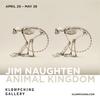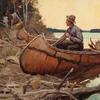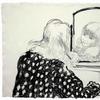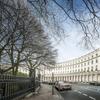Met Museum and National Gallery of Art, Washington, Each Acquire Significant Work by Leading Harlem Renaissance Artist Aaron Douglas
- NEW YORK, New York
- /
- May 14, 2015
he Metropolitan Museum of Art and the National Gallery of Art have each acquired a significant work by the leading visual artist of the Harlem Renaissance, Aaron Douglas (American, 1899–1979). The two paintings Let My People Go (ca. 1935–1939, Metropolitan Museum of Art) and The Judgment Day (1939, National Gallery of Art) derive from the acclaimed series Douglas created for James Weldon Johnson’s 1927 publication God's Trombones: Seven Negro Sermons in Verse. Together, these critical acquisitions assure that the artist’s rare easel paintings are represented in two of the nation’s most prominent public collections. Both were acquired from the private collector who purchased the works from Douglas in 1978.
Let My People Go is on view in Gallery 900 of the Met’s Lila Acheson Wing for modern and contemporary art. The Judgment Day will go on view this summer in the National Gallery of Art’s West Building, American Galleries.
Sheena Wagstaff, the Leonard A. Lauder Chairman of the Met’s Department of Modern and Contemporary Art at the Metropolitan Museum, said, “The appearance in our galleries of the beautiful and profound Let My People Go is not only transformative, but also, in a way, quite natural, given the Museum’s close proximity to Douglas’s adopted home of Harlem. The exceptional opportunity to acquire this important work allows us to reveal to our visitors more and richer facets of modern art in the United States. Additionally, it builds on the department’s recent major gift from the Souls Grown Deep Foundation of works by African American artists of the South, as well as recent acquisitions of significant works by Hale Woodruff, Sam Gilliam, and Kerry James Marshall.”
“After a long search for a major painting by Aaron Douglas, we are extraordinarily pleased to add the final work in Douglas’s God’s Trombones series to the nation’s collection,” said Nancy K. Anderson, curator and head, American and British paintings, National Gallery of Art, Washington. “Another work by Douglas, Into Bondage (1936), is one of some 142 new works by 69 African American artists—33 not previously represented here—that were recently acquired from the collection of the former Corcoran Gallery of Art. These include exceptional works by artists such as Sister Gertrude Morgan, Gordon Parks, Betye Saar, and Kara Walker, added to works already in our collection by Romare Bearden, Sam Gilliam, Martin Puryear, Kerry James Marshall, and many others.”
Aaron Douglas was born in Topeka, Kansas. After receiving a B.A. from the University of Nebraska (1922) and teaching art at an elite public high school for black students in Kansas City, Missouri, Douglas moved to the Harlem neighborhood of New York City, the cultural capital of black America throughout the early 20th century. In New York, Douglas studied art with the German modernist Winold Reiss, who first encouraged him to celebrate his "race pride" by incorporating African motifs and themes into his art. He also suggested that Douglas embrace an art-deco aesthetic expressive of the modern Jazz Age. Douglas quickly became an influential figure in the Harlem Renaissance, contributing his distinctive black-and-white graphic work to African American publications such as the NAACP's Crisis—whose editor, W. E. B. Du Bois, was a great supporter of the artist—and the National Urban League's Opportunity, as well as Vanity Fair. The artist’s centrality in the Harlem Renaissance’s cultural ferment was underscored when, in 1925, the literary critic and professor Dr. Alain Locke invited Douglas to contribute to The New Negro: An Interpretation, one of the most influential texts of the period.
At the age of 28, Douglas was invited by James Weldon Johnson to contribute illustrations to another revered Harlem Renaissance book, God's Trombones: Seven Negro Sermons in Verse, which the author based on traditional religious oratory. The resulting eight accompaniments to Johnson's poems rank among Douglas's most accomplished works. Douglas revisited, enlarged, and revised his eight compositions for God’s Trombones in easel paintings (on Masonite) through the 1930s. As the subjects appeared in God’s Trombones, the painting Let My People Go is the seventh in the sequence of eight images illuminating Johnson’s prose, with The Judgment Dayas the eighth.
Heralded as a muralist, Douglas painted Aspects of Negro Life, an ambitious mural cycle, under the auspices of the Public Works of Art Project for the 135th Street branch of the New York Public Library, now home of the Schomberg Center for Research in Black Culture. He served as Professor of Art at Fisk University, in Nashville, Tennessee, from 1939 until his retirement in 1966. Fisk, which holds Douglas’s papers, granted him an honorary doctorate in 1973. The fifth work in the series, Noah Built the Ark (1927), is in the collection of Fisk University Galleries.
About the Works
Let My People Go at The Metropolitan Museum of Art features Douglas’s distinctive silhouette style, with flat figurative forms and clear contours defined by monochromatic passages and restrained color. This style owed much to the renewed interest in Egyptian art following the unveiling of King Tutankhamun’s tomb (in 1922)—as well as a contemporary interest in Art Deco design and African art. The precedent of ancient Egyptian civilization was a frequent touchstone for Douglas as well as for figures associated with the Harlem Renaissance.
Rendered in an unusual palette of lavender and yellow-gold, it depicts the narrative in the Book of Exodus concerning God’s order to Moses to lead the Israelites out of captivity in Egypt. Divine light radiates out of the composition’s upper left corner in concentric arcs down to the kneeling figure of Moses near the opposite corner. The three Great Pyramids of Giza appear behind Moses, as small accumulations of vertical marks suggesting the masses of enslaved Israelites awaiting freedom. The pharaoh’s regiments gather for battle along the left side, filled also with stylized waves, which may allude to Moses’s parting of the Red Sea. Let My People Goexemplifies the artist’s appropriation of historical narratives as allegories relating to African American experience and identity. The Old Testament story of Moses resonated distinctly with the history of slavery among African American communities, having been invoked rhetorically and symbolically by ministers, abolitionists, and politicians alike over time.
The Judgment Day at the National Gallery of Art is the final painting in the series of eight. Illustrating Johnson’s poem based on the spiritual, “Blow Your Trumpet, Gabriel,” the work was acquired by the Gallery in 2014 and underwent conservation treatment. A powerful black Gabriel stands astride earth and sea—horn in one hand and keys to the kingdom in the other. The archangel sounds a trumpet to summon the nations of the earth to judgment. The souls of the dead are waking; two raise their hands in praise and recognition of the music. Conveyed by concentric circles and waves, the music echoes and reverberates throughout the work.
Recasting both the biblical narrative and the visual vocabulary of art deco and synthetic cubism, Douglas created an image as impassioned as the sermons of the black preachers celebrated inGod’s Trombones. To coincide with this historic acquisition, the National Gallery of Art Library has purchased a first edition of James Weldon Johnson’s God's Trombones: Seven Negro Sermons in Verse. “The music which awakens all nations,” in the words of Johnson, “is the song of a bluesman or a famous trumpet player.” To view this first edition, visitors may make an appointment by calling (202) 842-6511 or filling out the online form.














